
Phonics guidance for parents
At John Perryn, we follow the Read Write Inc programme for phonics from Nursery to Year 2
The information displayed here will explain the phonics teaching that your son / daughter will receive daily at school during their time in EYFS, Years 1 and 2.
It also provides information on how you can help support your son’s / daughter’s phonics development at home.
If you need clarification or would like to know more about our phonics teaching, please make an appointment to speak to your son’s /daughter’s class teacher.
Thank you for your continued support.
What are speed sounds?
In Read Write Inc phonics the individual sounds are called ‘speed sounds’ – because we want your son/daughter to read them effortlessly.
What are ‘speed sounds’ Set 1, Set 2 and Set 3?
Set 1
In Reception your child learns the sounds below by sight in this order. They also learnt how to blend them together to read words e.g. c-a-t ---} cat.
m, a, s, d, t, i, n, p, g, o, c, k, u, b, f, e, l, h, r, j, v, y, w, z and x. Once they have mastered these, they move on to the following 'special friends' (two words that make one sound): sh, th, ch, qu, ng, nk and ck
Set 2
(The long vowel sounds.) In Year 1 your child will progress to learning their Set 2 sounds in the Autumn Term and Set 3 sounds (reading only) in the Spring Term.
There are 12 Set 2 ‘speed sounds’ that are made up of two or three letters which represent just one sound, e.g. ay as in play, ee as in tree and igh as in high. It is important that your son/daughter does not pronounce these as 2 or 3 separate sounds. When your son/daughter sees the ‘speed sound’ letters together in a word, s/he must say just one sound for these letters.
When your son/daughter learns their Set 2 sounds in school they will learn:
- the letters that represent a speed sound e.g. ay
- a simple picture prompt linked to the ‘speed sound’ and a short phrase to say e.g. may I play
Every speed sound has a list of green words linked to it, so your son/daughter can ‘sound out’ and ‘sound blend’ words containing the new speed sound they have just learnt, for example s-p-r-ay -----} spray.
The Set 2 sounds are: ay, ee, igh, ow, oo, oo, ar, or, air, ir, ou and oy.

Set 3
To date, your son/daughter will have learnt one way in which each long vowel sound is written (Set 2 sounds). When learning their Set 3 speed sounds they will be taught that there are more ways in which the same sounds are written, e.g. ee as in tree and ea as in tea.
Set 3 speed sounds reading will be taught for most of Year 1 and Set 3 ‘speed sounds’ spelling during Year 2. It takes some time for this information to be fully understood by your son/daughter.
There are 20 Set 3 ‘speed sounds’ that are made up of two or three letters which represent just one sound, e.g. ea as in tea, ow as in cow and are as in care. As before, it is important that your son/daughter does not pronounce these as 2 or 3 separate sounds. When your son/daughter sees the ‘speed sound’ letters together in a word, s/he must say just one sound for these letters.
When your son/daughter learns their Set 3 sounds in school they will learn:
- the letters that represent a speed sounds e.g. ea
- a simple picture prompt linked to the ‘speed sound’ and a short phrase to say e.g. cup of tea
Every speed sound has a list of green words linked to it, so your son/daughter can ‘sound out’ and ‘sound blend’ words containing the new speed sound they have just learnt, for example s-p-oil ---} spoil.
The Set 3 sounds are: ea, oi, a-e, i-e, o-e, u-e, aw, are, ur, er, ow, ai, oa, ew, ire, ear and ure
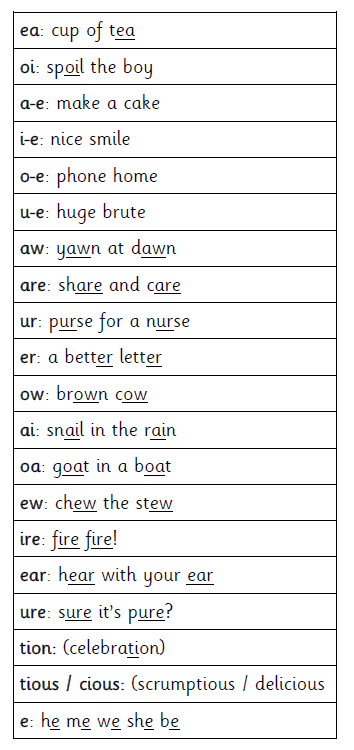
It is important that the speed sounds are practised in the correct order. The table above shows you, at a glance, the order of the sounds.
What are green words?
‘Green words’ are words which your son/daughter will be able to ‘go ahead’ and read as they are made up of the speed sounds that s/he will have learnt.
Resources for home use
Read Write Inc. Phonics: Home More Phonics Flashcards
We do not normally recommend buying flashcards for home use. However, we make an exception with these. They are great cards linked to the phonics scheme we do in school. You could use them with your son/daughter during their time in Year 1 and 2.
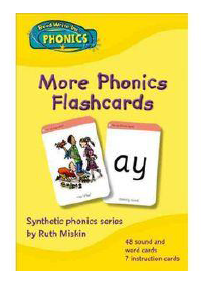
You can order them online for less than five pounds.
A great website that has lots of useful information on it to help you with supporting your son’s/daughter’s maths and reading development.
Activities to do at home with your child
You will need a pack of Set 2 and 3 Speed Sound cards (see resources for home).
Practise Set 2 ‘speed sounds’ in the Autumn Term (Year 1) and start practising Set 3, (Year 1) Spring Term onwards. (Please continue to practise Set 2 sounds as well during the Spring and Summer Terms).
How to practise Set 2 speed sounds
When you practise your son’s/daughter’s Set 2 ‘speed sounds’, you either have to stretch or bounce it.
Example of how to practise the stretchy speed sound ay (as in play)
- look at the picture side - stretch aaaaay
- stretch the sound and say the phrase aaaay, may I play?
- repeat the phrase ay, may I play?
- look at the letter side - say ay
- green words – encourage your son/daughter to ‘sound out’ and ‘sound blend’ the words containing the speed sound they have just practised e.g. t-r-ay ---} tray
Example of how to practise the bouncy speed sound oo (as in b-oo-k)
- look at the picture side - bounce the sound and say oo-oo-oo
- bounce the sound and say the phrase oo-oo-oo, Look at a book
- repeat the phrase oo, Look at a book
- look at the letter side - say oo
- green words – encourage your son/daughter to ‘sound out’ and ‘sound blend’ words containing the speed sound they have just practised.
Using the green word lists
- point to the sound as you ‘sound out’ each word e.g. p-l-ay or b-l-ow. Be sure you don’t add an intrusive ‘uh’ to the end of consonant sounds. Say p not puh, s not suh etc
- repeat, getting faster each time
- in the end your son/daughter will be able to read them without sounding or blending
Green words to practise at home
Please do not practice all these words. Concentrate on one or two sounds at a time and when they know them, move on.
12 words a night is ample. Encourage your son/daughter to highlight them when they can read them without sounding.
Set 2 Sounds
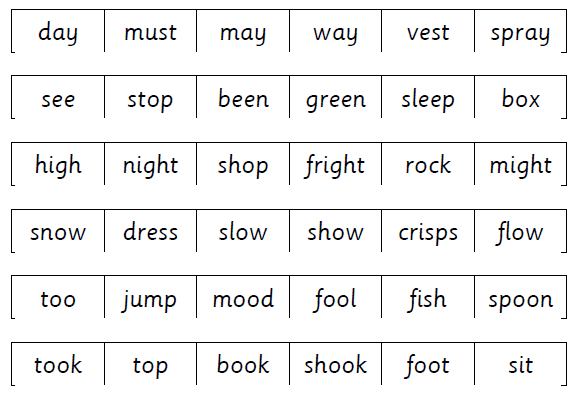

How to practise Set 3 speed sounds
Remember, only practise Set 3 speed sounds once your son’s/ daughter’s knowledge of the Set 2 ‘speed sounds’ is secure. Your son/daughter should know all the Set 2 sounds and the letters that represent them without having to rely on the picture prompt.
Example of how to practise Set 3 ‘speed sounds’
- Review the similar sound from the Set 2 cards
e.g. show the ee, what can you see speed card
say – ee sound - Hold up the letter side of the new speed sound
e.g. show the ea letter card say – ea ask your son/daughter to repeat the sound ea - Hold up the picture side of the speed sound card
e.g. say the phrase ea, cup of tea. Repeat - Show your child both sides of the card
your son/daughter must say either ea or ea, cup of tea depending on which side you show.
Some cards have three different spellings e.g. ir in bird, ur in burn, and er in fern. It is important you do not introduce all the sounds together for the first time. For the ir ‘speed sound’, practise ir and ur first and then practise er.
Practise the Set 3 speed sounds in these groups. Those in bold are from Set 3, those not in bold, your son/daughter will have learnt in Set 2.
oy and oi
ay and a-e (as in make)
igh and i-e (as in smile)
ow and o-e (as in home)
oo and u-e (as in huge)
or and aw
air and are
ir and ur
ay and a-e and ai
ow and o-e and oa
oo and u-e and ew
ire
ure
tion
cious/tious
Set 3 Sounds
Please do not practice all these words until your son/daughter knows all their Set 2 sounds. Concentrate on one sound at a time and when they know it, move on. 6 words a night is ample. Encourage your child to highlight them when they can read them without sounding.
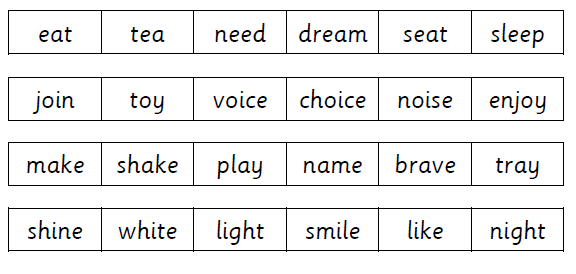
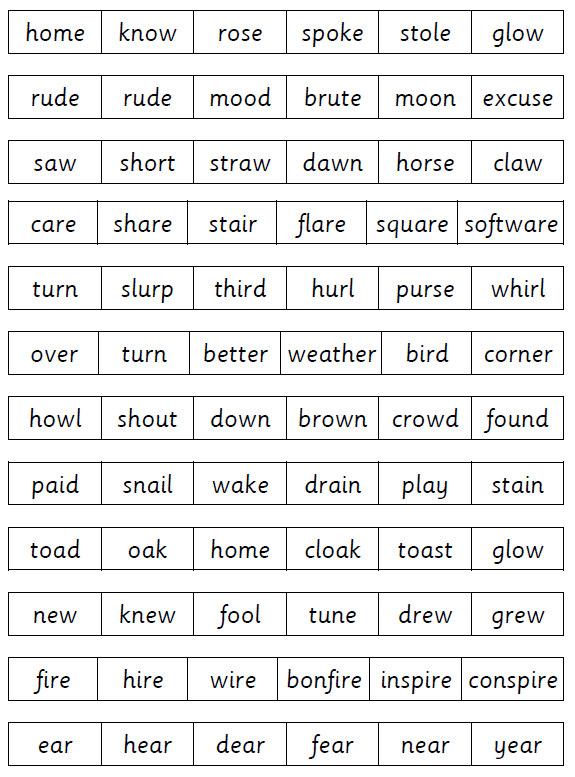
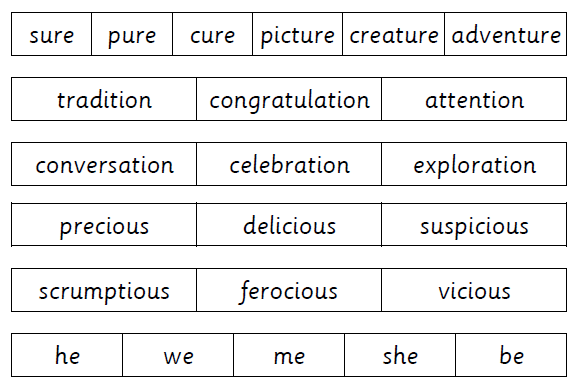
The Year 1 Phonic screening check
The phonics screening check will be taken individually by all children in Year 1, in England, from June 2012. It is designed to give teachers and parents, information on how your son/daughter is progressing in phonics.
What is the phonic screening check?
There will be two sections in this 40-word check and it will assess phonics skills and knowledge learnt through Reception and Year 1.
What will it check?
It will check that your son/daughter can:
- Sound out and blend sounds in order to read simple words.
- Read phonically decodable one-syllable and two-syllable words, e.g. cat, sand, windmill.
- Read a selection of nonsense words which are referred to as pseudo words.
What are nonsense or pseudo words and why are they included?
These are words that are phonically decodable but are not actual words with an associated meaning e.g. brip, snorb. Pseudo words are included in the check specifically to assess whether your son/daughter can decode a word using phonics skills and not their memory.
The pseudo words will be shown to your son/daughter with a picture of a monster and they will be asked to tell their teacher what sort of monster it is by reading the word. This not only makes the check a bit more fun, but provides the children with a context for the nonsense word which is independent from any existing vocabulary they may have. Crucially, it does not provide any clues, so your son/daughter just has to be able to decode it.
Is there a pass mark?
The check is not about passing or failing but checking appropriate progress is being made. Children progress at different speeds so not reaching the threshold score does not necessarily mean there is a serious problem. Your son/daughter will re-sit the check the following summer term.
What happens to the results?
The school will report your son’s/daughter’s results to you by the end of the summer term as well as to the local authority. If you have any concerns, do talk to your teacher about this in a parents’ meeting or after school.
More information can be found on www.oxfordowl.co.uk
Resource for home use
For those of you that have iPads and iPhones at home this is a great APP for your child.
Check your Phonics APP by Pearson Education
Description: The Learn at Home Check your Phonics app is a fun way for children, aged 5-6, to practise their phonics, & get used to the format of the Year 1 phonics check.
This app is designed for both iPhone and iPad
Category: Education
Updated: 05 November 2012
Version: 1.2
Size: 28.5 MB
Developer: Pearson Education Limited
© Pearson 2012
Requirements: Compatible with iPhone 3GS, iPhone 4, iPhone 4S, iPhone 5, iPod touch (3rd generation), iPod touch (4th generation), iPod touch (5th generation) & iPad. Requires iOS 4.0 or later.
To find out more about the phonics curriculum, please contact either the school office, speak to your child's class teacher or to the phonics subject coordinator Ms. Mulvany. Alternatively, click here to go to the Read, Write Inc website.
.png)